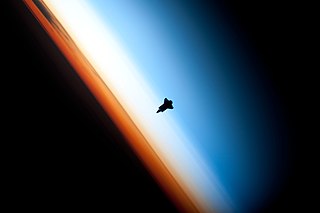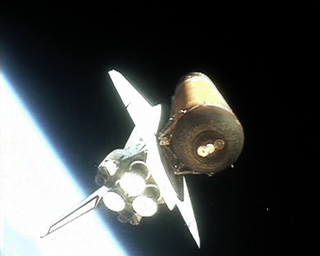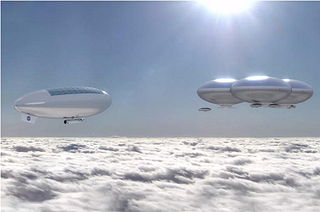
Jet streams are fast flowing, narrow, meandering air currents in the atmospheres of some planets, including Earth. On Earth, the main jet streams are located near the altitude of the tropopause and are westerly winds. Their paths typically have a meandering shape. Jet streams may start, stop, split into two or more parts, combine into one stream, or flow in various directions including opposite to the direction of the remainder of the jet.

The troposphere is the lowest layer of Earth's atmosphere, and is also where nearly all weather conditions take place. It contains 75% of the atmosphere's mass and 99% of the total mass of water vapour and aerosols. The average height of the troposphere is 18 km in the tropics, 17 km in the middle latitudes, and 6 km in the polar regions in winter. The total average height of the troposphere is 13 km.

The mesosphere is the third layer of the atmosphere, directly above the stratosphere and directly below the thermosphere. In the mesosphere, temperature decreases as altitude increases. This characteristic is used to define its limits: it begins at the top of the stratosphere, and ends at the mesopause, which is the coldest part of Earth's atmosphere with temperatures below −143 °C. The exact upper and lower boundaries of the mesosphere vary with latitude and with season, but the lower boundary is usually located at altitudes from 50 to 65 km above the Earth's surface and the upper boundary is usually around 85 to 100 km.
The thermosphere is the layer in the Earth's atmosphere directly above the mesosphere and below the exosphere. Within this layer of the atmosphere, ultraviolet radiation causes photoionization/photodissociation of molecules, creating ions; the thermosphere thus constitutes the larger part of the ionosphere. Taking its name from the Greek θερμός meaning heat, the thermosphere begins at about 80 km (50 mi) above sea level. At these high altitudes, the residual atmospheric gases sort into strata according to molecular mass. Thermospheric temperatures increase with altitude due to absorption of highly energetic solar radiation. Temperatures are highly dependent on solar activity, and can rise to 2000 °C (3,100 °F) or more. Radiation causes the atmosphere particles in this layer to become electrically charged particles, enabling radio waves to be refracted and thus be received beyond the horizon. In the exosphere, beginning at about 600 km (375 mi) above sea level, the atmosphere turns into space, although, by the judging criteria set for the definition of the Kármán line, the thermosphere itself is part of space.

A low Earth orbit (LEO) is an Earth-centred orbit with an altitude of 2,000 km (1,200 mi) or less, or with at least 11.25 periods per day and an eccentricity less than 0.25. Most of the artificial objects in outer space are in LEO.

The horizon is the apparent line that separates earth from sky, the line that divides all viewing directions based on whether it intersects the Earth's surface or not. The true horizon is actually a theoretical line, which can only be observed when it lies on the sea surface. At many locations, this line is obscured by land, trees, buildings, mountains, etc., and the resulting intersection of earth and sky is called the visible horizon. When looking at a sea from a shore, the part of the sea closest to the horizon is called the offing.
Altitude or height is a distance measurement, usually in the vertical or "up" direction, between a reference datum and a point or object. The exact definition and reference datum varies according to the context. Although the term altitude is commonly used to mean the height above sea level of a location, in geography the term elevation is often preferred for this usage.
The exosphere is a thin, atmosphere-like volume surrounding a planet or natural satellite where molecules are gravitationally bound to that body, but where the density is so low that the molecules are essentially collisionless. In the case of bodies with substantial atmospheres, such as Earth's atmosphere, the exosphere is the uppermost layer, where the atmosphere thins out and merges with outer space. It is located directly above the thermosphere. Very little is known about it due to lack of research. Mercury, the Moon and three Galilean satellites of Jupiter have surface boundary exospheres, which are exospheres without a denser atmosphere underneath. The Earth's exosphere is mostly hydrogen and helium, with some heavier atoms and molecules near the base.

The atmosphere of Earth is the layer of gases, commonly known as air, retained by Earth's gravity, surrounding the planet Earth and forming its planetary atmosphere. The atmosphere of Earth protects life on Earth by creating pressure allowing for liquid water to exist on the Earth's surface, absorbing ultraviolet solar radiation, warming the surface through heat retention, and reducing temperature extremes between day and night.
A sub-orbital spaceflight is a spaceflight in which the spacecraft reaches outer space, but its trajectory intersects the atmosphere or surface of the gravitating body from which it was launched, so that it will not complete one orbital revolution or reach escape velocity.

STS-66 was a Space Shuttle program mission that was flown by the Space Shuttle Atlantis. STS-66 launched on 3 November 1994 at 11:59:43.060 am EDT from Launch Pad 39-B at NASA's Kennedy Space Center. Atlantis landed at Edwards Air Force Base on 14 November 1994 at 10:33:45 am EST.
A geocentric orbit or Earth orbit involves any object orbiting the Earth, such as the Moon or artificial satellites. In 1997 NASA estimated there were approximately 2,465 artificial satellite payloads orbiting the Earth and 6,216 pieces of space debris as tracked by the Goddard Space Flight Center. Over 16,291 previously launched objects have decayed into the Earth's atmosphere.
The Kármán line is an attempt to define a boundary between Earth's atmosphere and outer space. This is important for legal and regulatory measures; aircraft and spacecraft fall under different jurisdictions and are subject to different treaties.

An orbital spaceflight is a spaceflight in which a spacecraft is placed on a trajectory where it could remain in space for at least one orbit. To do this around the Earth, it must be on a free trajectory which has an altitude at perigee around 80 kilometers (50 mi); this is the boundary of space as defined by NASA, the US Air Force and the FAA. To remain in orbit at this altitude requires an orbital speed of ~7.8 km/s. Orbital speed is slower for higher orbits, but attaining them requires greater delta-v.
Upper atmosphere is a collective term that refers to various layers of the atmosphere of the Earth and corresponding regions of the atmospheres of other planets, and includes:

The colonization of Venus has been a subject of many works of science fiction since before the dawn of spaceflight, and is still discussed from both a fictional and a scientific standpoint. However, with the discovery of Venus's extremely hostile surface environment, attention has largely shifted towards the colonization of the Moon and Mars instead, with proposals for Venus focused on colonies floating in the upper-middle atmosphere and on terraforming.

Atmospheric temperature is a measure of temperature at different levels of the Earth's atmosphere. It is governed by many factors, including incoming solar radiation, humidity and altitude. When discussing surface air temperature, the annual atmospheric temperature range at any geographical location depends largely upon the type of biome, as measured by the Köppen climate classification
Lower atmosphere is a collective term sometimes used to refer to various layers of the atmosphere of the Earth and corresponding regions of the atmospheres of other planets, and includes:
Nuclear blackout, also known as fireball blackout or radar blackout, is an effect caused by explosions of nuclear weapons that disturbs radio communications and causes radar systems to be blacked out or heavily refracted so they can no longer be used for accurate tracking and guidance. Within the atmosphere, the effect is caused by the large volume of ionized air created by the energy of the explosion, while above the atmosphere it is due to the action of high-energy beta particles released from the decaying bomb debris. At high altitudes, the effect can spread over large areas, hundreds of kilometers. The effect slowly fades as the fireball dissipates.

This glossary of meteorology is a list of terms and concepts relevant to meteorology and atmospheric science, their sub-disciplines, and related fields.









